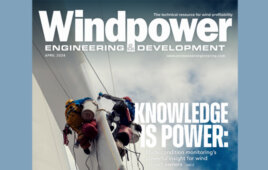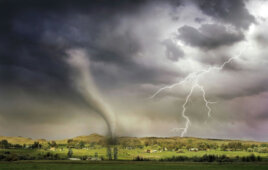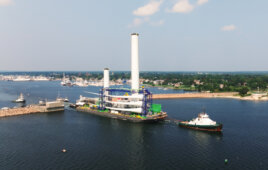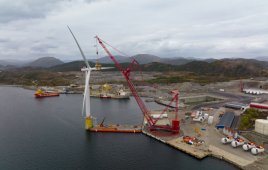By Fabio Fracaroli, Senior Director, Renewable Segment North America, ABB Power Grids
As the offshore wind power market in the United States continues to mature, developers are having to come to grips with a complex regulatory landscape before pushing projects forward. The primary driver behind those regulations is the Bureau of Ocean Energy Management (BOEM) which oversees development of renewable energy projects on the Outer Continental Shelf and grants associated leases. BOEM’s offshore wind energy program includes four phases: planning and analysis, leasing, site assessment, as well as construction and operations, each of which brings its own regulatory requirements.
Environmental impact
 The first phase of the BOEM process involves conducting studies of potential impacts on wildlife as well as other environmental considerations. Major environmental concerns related to offshore wind developments include increased noise levels, risk of collisions, changes to oceanic wildlife habitats, alterations to food webs and pollution from increased vessel traffic or release of contaminants from seabed sediments. The Wind Energy Technologies Office (WETO), part of the Department of Energy, is tasked with assessing and mitigating environmental impacts of wind energy projects and has conducted extensive research to help ensure they provide a net environmental benefit. As they accumulate knowledge around the environmental impact of offshore projects grows, developers need to consider all of this information during the planning phase. It takes a wealth of knowledge and experience to efficiently navigate this process and ensure that developers are initiating projects in locations where the likelihood of approval is high.
The first phase of the BOEM process involves conducting studies of potential impacts on wildlife as well as other environmental considerations. Major environmental concerns related to offshore wind developments include increased noise levels, risk of collisions, changes to oceanic wildlife habitats, alterations to food webs and pollution from increased vessel traffic or release of contaminants from seabed sediments. The Wind Energy Technologies Office (WETO), part of the Department of Energy, is tasked with assessing and mitigating environmental impacts of wind energy projects and has conducted extensive research to help ensure they provide a net environmental benefit. As they accumulate knowledge around the environmental impact of offshore projects grows, developers need to consider all of this information during the planning phase. It takes a wealth of knowledge and experience to efficiently navigate this process and ensure that developers are initiating projects in locations where the likelihood of approval is high.
Grid compliance
Another critical component of the planning and analysis phase is ensuring proper interconnection and grid compliance. Shoring up interconnection plans is necessary for local regional transmission organization/independent system operator (RTO/ISO) feasibility and impact assessments that will follow. Accounting for the right technologies during the RTO/ISO process is crucial because solutions proposed during this first phase of development are what must be implemented if the plan is approved. That planning process can take a year or longer, making it potentially disastrous if developers are required to start over due to an oversight in their applications. Ensuring grid compliance in the early phases of development can also include fatal flaw studies, conceptual design of transmission systems, and cost and risk assessment. Later, a specialized interconnection study can be conducted during the site assessment phase to evaluate primary systems and optimal components to help a developer understand economic and reliability options for landfall interconnection.
Cybersecurity

Throughout the planning process, developers must also take into consideration the North American Electric Reliability Corporation critical infrastructure protection plan (NERC-CIP), which consists of nine standards and 45 requirements covering the security of electronic perimeters and the protection of critical cyber assets, as well as personnel and training, security management and disaster recovery planning.
Cybersecurity is a key component of NERC-CIP compliance, especially when leveraging digitalized assets that can be especially vulnerable without proper protection. As such, developers need to plan for multiple layers of defense embedded in substation automation and control system architecture. Those systems can be leveraged to save millions of dollars through remote access and management as opposed to transfer of personnel to and from offshore installations, but they require additional expertise to execute effectively.
It is also best to ensure that grid automation systems follow industrial best practice guidelines outlined in such standards as IEC 62443, IEC 62351, IEEE 1686, as well as the BDEW. To achieve this, developers can leverage several key technologies and strategies that can play a meaningful role in helping address cybersecurity concerns. Firewalls (including next-generation firewalls), patch management, access control and detailed audit trails of all security-relevant user activities are prime examples.
Grid interconnection
 Another concern with offshore projects, especially in the United States, is the reality that existing transmission systems, which are typically developed to support large, centralized fossil-fuel and nuclear-based power stations are generally located away from the coast. The loads near the coastline are often at the very end of that transmission grid and there are few existing substations capable of receiving and transmitting power from major new generation facilities located offshore. Hence, interconnection and integration of such facilities into the existing grid is arguably one of the most critical dependencies for the future success of offshore wind. For developers, it can also be one of the most difficult ones to manage without in-depth knowledge of the U.S. grid infrastructure and the utility companies that support it.
Another concern with offshore projects, especially in the United States, is the reality that existing transmission systems, which are typically developed to support large, centralized fossil-fuel and nuclear-based power stations are generally located away from the coast. The loads near the coastline are often at the very end of that transmission grid and there are few existing substations capable of receiving and transmitting power from major new generation facilities located offshore. Hence, interconnection and integration of such facilities into the existing grid is arguably one of the most critical dependencies for the future success of offshore wind. For developers, it can also be one of the most difficult ones to manage without in-depth knowledge of the U.S. grid infrastructure and the utility companies that support it.
As it relates to regulatory requirements, it is important to address the various interconnection issues driven by grid code, NERC and ISO requirements. A few of the primary concerns include:
- Addressing the reactive power and black-start capability needs of the grid as fossil-fuel and nuclear based generation units retire and are replaced by intermittent wind resources.
- Defining performance during normal and contingency conditions.
- Considering the effect of cable system energization generator synchronization on system voltage and any alternatives for meeting reactive power capabilities.
To help address some of these concerns, flexible AC transmission systems (FACTS) devices such as energy storage systems, synchronous condensers and HVDC VSC can provide voltage regulation and reactive power support to the grid at the interconnection point. Battery energy storage systems and synchronous condensers can also provide synthetic inertia to improve performance and frequency response of a grid that relies on a high percentage of wind-generated and relatively low levels of traditional fossil-fuel based or hydro-based generation. This is most effective in scenarios where wind energy becomes a significant part of the overall power generation capacity in the grid, and other resources must therefore be able to quickly offset the fluctuations in wind power generation to balance the real and reactive power requirements of the loads.
Additionally, shunt reactors can be used to increase the energy efficiency of long AC cable systems by absorbing the reactive power (charging current) generated within the cable. A shunt reactor can be directly connected to the power circuit or to a tertiary winding of a three-winding transformer. It can then be permanently connected or switched via a circuit breaker. To improve the adjustment of the consumed reactive power the reactor can also have a variable rating. If the load variation is slow, which it normally is (seasonal, daily or hourly), a variable shunt reactor (VSR) could be an economical solution for some applications.
Conclusion
As one can imagine, this only scratches the surface of the complex regulatory environment facing offshore wind developers and represents just one piece of the puzzle that must come together to successfully execute a project. Developers also face an array of technical, physical and budgetary challenges along the way. Taken as a whole, such ventures can certainly seem daunting. However, when backed by the proper knowledge, experience and resources, wind energy projects in the United States can be a major force in pushing clean energy forward at a time when the planet needs it most.
 Fabio Fracaroli leads business and market development activities for the Renewables Segment in North America for ABB Power Grids. A sales and market leader with 18+ years of international experience in manufacturing, project management and business development in the power industry, Fabio is passionate about the energy market, and has broad knowledge of industrials markets such as chemicals, oil & gas, transportation, metals & mining, data centers and renewables.
Fabio Fracaroli leads business and market development activities for the Renewables Segment in North America for ABB Power Grids. A sales and market leader with 18+ years of international experience in manufacturing, project management and business development in the power industry, Fabio is passionate about the energy market, and has broad knowledge of industrials markets such as chemicals, oil & gas, transportation, metals & mining, data centers and renewables.
Filed Under: Featured, Offshore wind, Projects





in the north sea, the countries have different legal regimes for their offshore wind energy. the transportation of electricity from the EEZ of one country through the EEZ/ TERRITORIAL WATERS is required an agreement between those countries.how to harmonise these regimes?